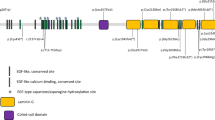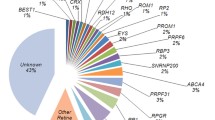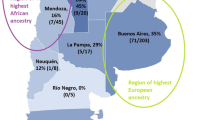Abstract
Background and aim
Congenital hypertrophy of the retinal pigment epithelium (CHRPE) is a pigmented fundus lesion associated with familial adenomatous polyposis (FAP). CHRPE prevalence has been reported to be increased in subjects with familial or sporadic non-polyposis colorectal cancer (CRC), suggesting that some individuals with non-polyposis CRC have an attenuated form of FAP. Other studies have not confirmed these clinical observations and have failed to identify mutations in the gene responsible for FAP, but the reason for the discrepancy in relation to CHRPE prevalence has not been resolved. We determined the prevalence of CHRPE in subjects without CRC (negative control cohort), subjects with FAP (positive control cohort), and subjects with familial non-polyposis CRC (test cohort).
Method
A cohort study consisting of 37 negative control subjects, 9 positive control subjects with documented APC gene mutations, and 36 test subjects with familial non-polyposis CRC but no identified pathogenic APC gene mutation. The diagnosis of hereditary non-polyposis colon cancer was excluded in the test cohort by testing for microsatellite instability in tumour tissue.
Results
None of the 37 people in the negative control group had CHRPE. Five of nine (56%) patients with FAP had multiple CHRPE lesions. None of the 36 subjects in the test cohort had CHRPE lesions.
Conclusions
Ophthalmoscopy may contribute to risk assessment in families with FAP but not in familial non-polyposis CRC. Care must be exercised when interpreting pigmented fundus lesions because 8–13% of subjects in each of the cohorts had pigmented retinal lesions that were not CHRPE. Bilateral lesions and lesions with a depigmented halo␣were the hallmarks of CHRPE associated with FAP.
Similar content being viewed by others
References
Kinzler KW, Vogelstein B (2002) Colorectal tumors. In: Vogelstein B, Kinzler KW (eds) The genetic basis of human cancer, 2nd edn. McGraw-Hill, New York
Giardiello FM, Petersen GM, Piantadosi S et al (1997) APC gene mutations and extraintestinal phenotype of familial adenomatous polyposis. Gut 40:521–525
Knudsen AL, Bisgaard ML, Bulow S (2003) Attenuated familial adenomatous polyposis (AFAP). A Rev Literature Fam Cancer 2:43–45
Michils G, Tejpar S, Fryns JP et al (2002) Pathogenic mutations and rare variants of the APC gene identified in 75 Belgian patients with familial adenomatous polyposis by fluorescent enzymatic mutation detection (EMD). Eur J Hum Genet 10:505–510
Burn J, Chapman P, Delhanty J et al (1991) The UK Northern Region genetic register for familial adenomatous polyposis coli: use of age of onset, congenital hypertrophy of the retinal pigment epithelium, and DNA markers in risk calculations. J Med Genet 28:289–296
Houlston RS, Fallon T, Harocopos C et al (1992) Congenital hypertrophy of retinal pigment epithelium in patients with colonic polyps associated with cancer family syndrome. Clin Genet 42:16–18
Ziskind A, Kitze MJ, Grobbelaar JJ (1999) The relationship between congenital hypertrophy of the retinal pigment epithelium (CHRPE) and germline mutations in the adenomatous polyposis coli (APC) gene. Ophthalmic Genet 20:53–56
Baba S, Tsuchiya M, Watanabe I et al (1990) Importance of retinal pigmentation as a subclinical marker in familial adenomatous polyposis. Dis Colon Rectum 33:660–665
Hunt LM, Robinson MHE, Hugkulstone CE et al (1994) Congenital hypertrophy of the retinal pigment epithelium and mandibular osteomata as markers in familial colorectal cancer. Br J Cancer 70:173–176
Tiret A, Parc C (1999) Fundus lesions of adenomatous polyposis. Curr Opin Ophthalmol 10:168–172
Morton DG, Gibson J, Macdonald F et al (1992) Role of congenital hypertrophy of the retinal pigment epithelium in the predictive diagnosis of familial adenomatous polyposis. Br J Surg 79:689–693
Hodgson SV, Bishop DT, Jay B (1994) Genetic heterogeneity of congenital hypertrophy of the retinal pigment epithelium (CHRPE) in families with familial adenomatous polyposis. J Med Genet 31:55–58
Olea JL, Mateos JM, Llompart A et al (1996) Frequency of congenital hypertrophy of the retinal pigment epithelium in familial adenomatous polyposis. Acta Ophthalmol Scand 74:48–50
Berk T, Cohen Z, McLeod RS et al (1988) Congenital hypertrophy of the retinal pigment epithelium as a marker for familial adenomatous polyposis. Dis Colon Rectum 31:253–257
Polkinghorne PJ, Ritchie S, Neale K et al (1990) Pigmented lesions of the retinal pigment epithelium and familial adenomatous polyposis. Eye 4:216–221
Tourino R, Conde-Freire R, Cabezas-Agricola JM et al (2004) Value of the congenital hypertrophy of the retinal pigment epithelium in the diagnosis of familial adenomatous polyposis. Int Ophthalmol 25:101–112
Traboulsi EI, Apostolides J, Giardiello FM et al (1996) Pigmented ocular fundus lesions and APC mutations in familial adenomatous polyposis. Ophthalmic Genet 17:167–174
Shields CL, Mashayekhi A, Ho T et al (2003) Solitary congenital hypertrophy of the retinal pigment epithelium: clinical features and frequency of enlargement in 330 patients. Ophthalmology 110:1968–1976
Dunlop MG, Farrington SM, Bubb VJ et al (1996) Extracolonic features of familial adenomatous polyposis in patients with sporadic colorectal cancer. Br J Cancer 74:1789–1795
Hartvigsen A, Myrhoj T, Bulow S et al (1995) Ophthalmoscopy for congenital hypertrophy of the retinal pigment epithelium (CHRPE) in patients with sporadic colorectal carcinoma. Int J Colorectal Dis 10:138–139
Joyce JA, Froggatt NJ, Davies R et al (1995) Molecular genetic analysis of exons 1 to 6 of the APC gene in non-polyposis familial colorectal cancer. Clin Genet 48:299–303
Boardman LA, Schmidt S, Lindor NM et al (2001) A search for germline APC mutations in early onset colorectal cancer or familial colorectal cancer with normal DNA mismatch repair. Genes Chrom Cancer 30:181–186
Ruszkiewicz A, Bennett G, Moore J et al (2002) Correlation of mismatch repair genes immunohistochemistry and microsatellite instability status in HNPCC-associated tumours. Pathology 34:541–547
National Health and Medical Research Council (1990) Guidelines for the prevention, early detection and management of colorectal cancer. http: //www.nhmrc.gov.au/publications/synopses/cp62syn.htm Cited 29 March 2004
Jass JR (2005) What’s new in hereditary colorectal cancer? Arch Pathol Lab Med 129:1380–1384
Groden J, Thliveris A, Samowitz W et al (1991) Identification and characterization of the familial adenomatous polyposis coli gene. Cell 66:589–600
Miyoshi Y, Ando H, Nagase H et al (1992) Germ-line mutations of the APC gene in 53 familial adenomatous polyposis patients. Proc Natl Acad Sci 89:4452–4456
Wu G, Wu W, Hegde M et al (2001) Detection of sequence variations in the adenomatous polyposis coli (APC) gene using denaturing high-performance liquid chromatography. Genet Test 5:281–290
van der Luijt RB, Khan PM, Vasen HF et al (1997) Molecular analysis of the APC gene in 105 Dutch kindreds with familial adenomatous polyposis: 67 germline mutations identified by DGGE, PTT, and southern analysis. Hum Mutat 9:7–16
Regev M, Barzilai SE, Figer A et al (2005) The I1307K APC mutation in a high-risk clinic setting: a follow-up study. Clin Genet 67:352–355
Caspari R, Friedl W, Boker T et al (1993) Predictive diagnosis in familial adenomatous polyposis: evaluation of molecular genetic and ophthalmologic methods. Z Gastroenterol 31:646–652
Caspari R, Olschwang S, Friedl W et al (1995) Familial adenomatous polyposis: demsoid tumours and lack of ophthalmic lesions (CHRPE) associated with APC mutations beyond codon 1444. Hum Mol Genet 4:337–340
Olschwang S, Tiret A, Laurent-Puig P et al (1993) Restriction of ocular fundus lesions to a specific subgroup of APC mutations in adenomatous polyposis coli patients. Cell 75:959–968
Lynch HT, Smyrk T, McGinn T et al (1995) Attenuated familial adenomatous polyposis (AFAP): aphenotypically and genotypically distinctive variant of FAP. Cancer 76:2427–2433
Marchese CA, Bertolino F, Ceccopieri B et al (1996) Clinical findings in a family with familial adenomatous polyposis and a missense mutation of the adenomatous polyposis coli gene. Scand J Gastroenterol 31:917–920
Traboulsi E, Krush AJ, Gardner EJ et al (1987) Prevalence and importance of pigmented ocular fundus lesions in Gardner’s syndrome. N Engl J Med 316:661–667
Gass JDM (1987) Stereoscopic atlas of macular disease: diagnosis and treatment. CV Mosby, St. Louis
Valanzano R, Cama A, Volpe R et al (1996) Congential hypertrophy of the retinal pigment epithelium in familial adenomatous polyposis. Novel criteria of assessment and correlation with constitutional adenomatous polyposis coli gene mutation. Cancer 78:2400–2410
Shields JA, Shields CL, Shah PG et al (1992) Lack of association among typical congenital hypertrophy of the retinal pigment epithelium, adenomatous polyposis, and Gardner syndrome. Ophthalmology 99:1709–1713
Parson MA, Rennie IG, Rundle PA (2005) Congenital hypertrophy of retinal pigment epithelium: a clinico-pathological case report. Br J Ophthalmol 89:920–921
Kasner L, Traboulsi EI, Delacruz Z et al (1992) A histopathologic study of the pigmented fundus lesions in familial adenomatous polyposis. Retina 12:35–42
Hennesey MP (1994) The distinction between multiple retinal pigment epithelial hamartomata (MRPEH) in familial adenomatous polyposis (FAP) and congenital hypertrophy of the retinal pigment epithelium (CHRPE). ANZ J Ophthalmol 23:275–276
Traboulsi EI, Murphy SF, Delacruz ZC et al (1990) A clinicopathologic study of the eyes with extracolonic manifestations (Gardner’s syndrome). Am J Ophthalmol 110:550–561
Acknowledgements
We thank the subjects for their participation, the Perpetual Trustee for financial support, the staff of the Familial Cancer Unit for assistance with patient recruitment, and Drs. Trevor Hodson, Mark Perks, and Philip Clem for their assistance. This work was supported by a grant from the Baxter Charitable Foundation, Perpetual Trustee, Sydney, Australia (CSC). JEC is supported by a Practitioner-Fellowship from the National Health and Medical Research Council.
Author information
Authors and Affiliations
Corresponding author
Rights and permissions
About this article
Cite this article
Chen, C.S., Phillips, K.D., Grist, S. et al. Congenital hypertrophy of the retinal pigment epithelium (CHRPE) in familial colorectal cancer. Familial Cancer 5, 397–404 (2006). https://doi.org/10.1007/s10689-006-0011-y
Received:
Accepted:
Published:
Issue Date:
DOI: https://doi.org/10.1007/s10689-006-0011-y




